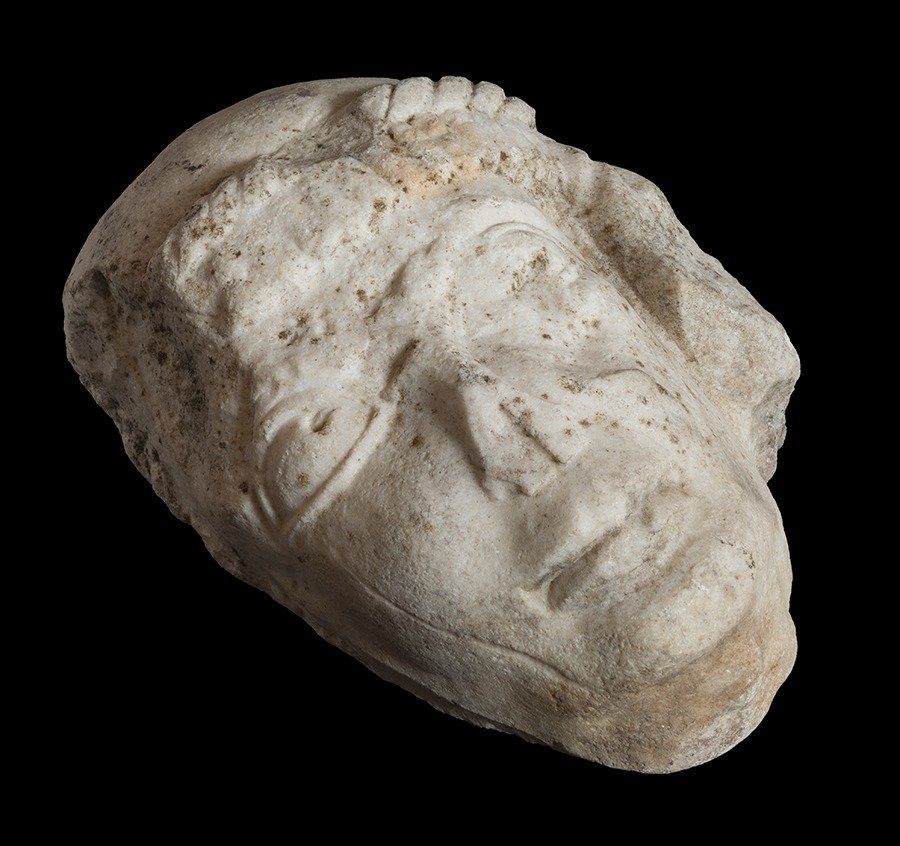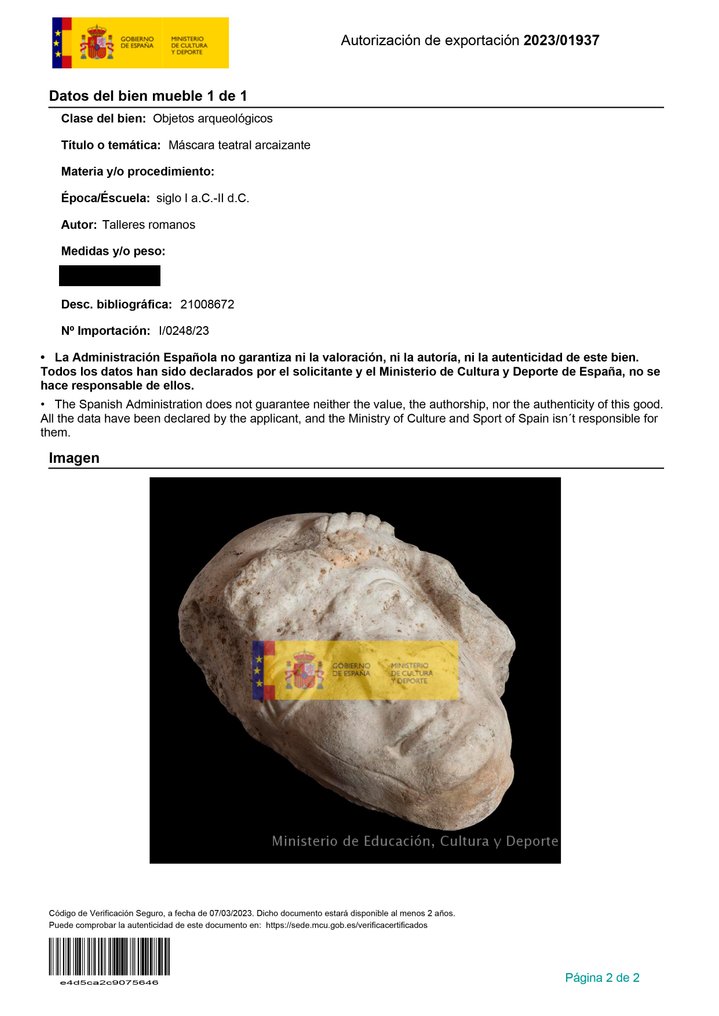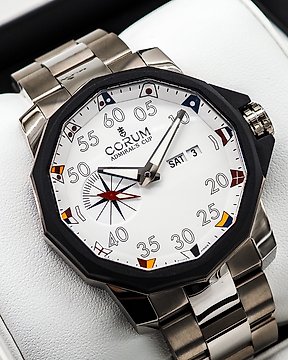perfect ! very fast and high quality delivery !
Προβολή μετάφρασηςΑρχαία Ρωμαϊκή Μάρμαρο θεατρική μάσκα. 29 cm Υ. Τεράστιο και σημαντικό. Ισπανική άδεια εξαγωγής.
Αρ. 84870893




theatrical mask.
Roman Empire, 1st century B.C. - 2nd century AD.
Material: Marble.
Provenance: Private Collection of Bengt Söderbergh (1925-2019), Cannes, France.
Without restorations.
Measures: 29 x 20 cm.
Theater mask with markedly archaic features, an aspect appreciable in the large almond-shaped eyes, in the hieratism of the face and in the headdress that the personage wears. The ethnologists place the birth of the mask in the moment in which the self-consciousness is produced. Its use dates back to the most distant antiquity, being found among the Egyptians, Greeks and Romans. The Greeks used them in the Dionysian festivities; the Romans during the Lupercal and Saturnalia and also in the scenic representations.
The Romans brought two important innovations to the world of sculpture: the portrait and the historical relief, neither of which existed in the Greek world. However, they followed the Greek models for a large part of their sculptural production, a base that in Rome was combined with the Etruscan tradition. After the first contacts with the Greece of classicism through the colonies of Magna Graecia, the Romans conquered Syracuse in 212 BC, a rich and important Greek colony located in Sicily, adorned with a large number of Hellenistic works. The city was sacked and its artistic treasures taken to Rome, where the new style of these works soon replaced the Etruscan-Roman tradition that had prevailed until then. Cato himself denounced the sacking and decoration of Rome with Hellenistic works, which he considered a dangerous influence on native culture, and deplored the Romans' applauding of statues from Corinth and Athens, while ridiculing the decorative terracotta tradition of ancient Roman temples. However, these oppositional reactions were in vain; Greek art had subdued Etruscan-Roman art in general, to the point that Greek statues were among the most coveted prizes of war, being displayed during the triumphal procession of the conquering generals.
NOTES:
- The piece includes authenticity certificate.
- The piece includes Spanish Export License.
- The seller guarantees that he acquired this piece according to all national and international laws related to the ownership of cultural property. Provenance statement seen by Catawiki.
THE MINISTRY OF CULTURE FROM SPAIN ASKS ALL SELLERS FOR INVOICES OR OTHER DOCUMENTATION ABLE TO PROVE THE LEGALITY OF EACH ITEM BEFORE PROVIDING AN IMPORT OR EXPORT LICENSE.
#ancientcivilisations
Ιστορία πωλητή
theatrical mask.
Roman Empire, 1st century B.C. - 2nd century AD.
Material: Marble.
Provenance: Private Collection of Bengt Söderbergh (1925-2019), Cannes, France.
Without restorations.
Measures: 29 x 20 cm.
Theater mask with markedly archaic features, an aspect appreciable in the large almond-shaped eyes, in the hieratism of the face and in the headdress that the personage wears. The ethnologists place the birth of the mask in the moment in which the self-consciousness is produced. Its use dates back to the most distant antiquity, being found among the Egyptians, Greeks and Romans. The Greeks used them in the Dionysian festivities; the Romans during the Lupercal and Saturnalia and also in the scenic representations.
The Romans brought two important innovations to the world of sculpture: the portrait and the historical relief, neither of which existed in the Greek world. However, they followed the Greek models for a large part of their sculptural production, a base that in Rome was combined with the Etruscan tradition. After the first contacts with the Greece of classicism through the colonies of Magna Graecia, the Romans conquered Syracuse in 212 BC, a rich and important Greek colony located in Sicily, adorned with a large number of Hellenistic works. The city was sacked and its artistic treasures taken to Rome, where the new style of these works soon replaced the Etruscan-Roman tradition that had prevailed until then. Cato himself denounced the sacking and decoration of Rome with Hellenistic works, which he considered a dangerous influence on native culture, and deplored the Romans' applauding of statues from Corinth and Athens, while ridiculing the decorative terracotta tradition of ancient Roman temples. However, these oppositional reactions were in vain; Greek art had subdued Etruscan-Roman art in general, to the point that Greek statues were among the most coveted prizes of war, being displayed during the triumphal procession of the conquering generals.
NOTES:
- The piece includes authenticity certificate.
- The piece includes Spanish Export License.
- The seller guarantees that he acquired this piece according to all national and international laws related to the ownership of cultural property. Provenance statement seen by Catawiki.
THE MINISTRY OF CULTURE FROM SPAIN ASKS ALL SELLERS FOR INVOICES OR OTHER DOCUMENTATION ABLE TO PROVE THE LEGALITY OF EACH ITEM BEFORE PROVIDING AN IMPORT OR EXPORT LICENSE.
#ancientcivilisations
Ιστορία πωλητή
- 750
- 6
- 0
All well! Thanks.
Προβολή μετάφρασηςVendeur très professionnel, top +++×
Προβολή μετάφρασηςPhotos trop contrastées pour bien percevoir les défauts, mais ces défauts étaient visibles pour autant. Le "Bon état" est trompeur. Sinon, envoi rapide et correctement emballé. Frais de port exagérés.
Προβολή μετάφρασηςGreat communication, delivery and product. Came with a well made certificate of authenticity and good packaging. Overall very happy with the purchase! Delivery is a bit expensive, but I recommend it
Προβολή μετάφρασηςMagnifique témoin du passé, envoyé avec tous les justificatifs, impeccable. Encore une fois très satisfait, un grand merci
Προβολή μετάφρασηςThank you for the Special offer and the fast shipping of this excellent piece of art!
Προβολή μετάφρασηςvery good description of the object, very good price for this rare item,. Fast sending (has been at my place 2 days after buying!). Definitely would buy again.
Προβολή μετάφρασηςSehr schön
Προβολή μετάφρασηςAs described, perfect logistic
Προβολή μετάφρασηςgreat seller, everything came as should with certificate of authenticity
Προβολή μετάφρασηςExceptionally well packaged, description aligned with positing received
Προβολή μετάφρασηςReally precious, but without sound...
Προβολή μετάφρασηςPainting well packed and rapidly sent!
Προβολή μετάφρασηςsempre grande rapidità e professionalità
Προβολή μετάφρασηςparfait bien reçu, merci
Προβολή μετάφρασηςVery satisfied with the small Greek Lekythos. As always (we have already bought several items from Bagot), the object was wrapped and sent immediately and with the greatest care.
Προβολή μετάφρασηςPerfect, excellent condition, good packaging, the parcel arrived without any problems… all is perfect as usual. Thank you very much and wait for an other nice piece like this one. Gilles.
Προβολή μετάφρασης+++ Top vendeur professionnel comme d'habitude
Προβολή μετάφρασηςEmbora o custo de transporte esteja acima da média foi, realmente, muito bem executado e em embalagem cuidada. Expeditos e profissionais. Recomendo
Προβολή μετάφρασηςSnel en correct en goed verpakt verzonden
Προβολή μετάφρασηςoggetto bellissimo, fedele alla descrizione, venditore affidabile
Προβολή μετάφρασηςVery nice piece and fast delivery
Προβολή μετάφρασηςEverything ok, top seller! Thank you again!
Προβολή μετάφρασηςvery beautiful and fast shipping!thank you!
Προβολή μετάφρασης- 750
- 6
- 0
perfect ! very fast and high quality delivery !
Προβολή μετάφρασηςΑποποίηση ευθυνών
Ο πωλητής εγγυάται και μπορεί να αποδείξει ότι το αντικείμενο αποκτήθηκε νόμιμα. Ο πωλητής ενημερώθηκε από την Catawiki ότι έπρεπε να παράσχει τα δικαιολογητικά που απαιτούνται από τους νόμους και τους κανονισμούς στη χώρα διαμονής τους. Ο πωλητής εγγυάται και δικαιούται να πουλήσει/εξάγει αυτό το αντικείμενο. Ο πωλητής θα παρέχει στον αγοραστή όλες τις πληροφορίες προέλευσης που είναι γνωστές για το αντικείμενο. Ο πωλητής διασφαλίζει ότι οποιεσδήποτε απαραίτητες άδειες έχουν ήδη κανονιστεί /θα κανονιστεί. Ο πωλητής θα ενημερώσει αμέσως τον αγοραστή για τυχόν καθυστερήσεις στην απόκτηση τέτοιων αδειών.
Ο πωλητής εγγυάται και μπορεί να αποδείξει ότι το αντικείμενο αποκτήθηκε νόμιμα. Ο πωλητής ενημερώθηκε από την Catawiki ότι έπρεπε να παράσχει τα δικαιολογητικά που απαιτούνται από τους νόμους και τους κανονισμούς στη χώρα διαμονής τους. Ο πωλητής εγγυάται και δικαιούται να πουλήσει/εξάγει αυτό το αντικείμενο. Ο πωλητής θα παρέχει στον αγοραστή όλες τις πληροφορίες προέλευσης που είναι γνωστές για το αντικείμενο. Ο πωλητής διασφαλίζει ότι οποιεσδήποτε απαραίτητες άδειες έχουν ήδη κανονιστεί /θα κανονιστεί. Ο πωλητής θα ενημερώσει αμέσως τον αγοραστή για τυχόν καθυστερήσεις στην απόκτηση τέτοιων αδειών.









